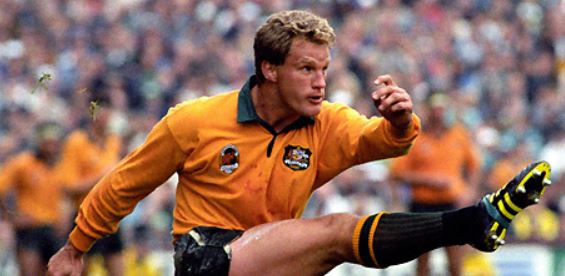Biography
Michael Patrick Thomas Lynagh, AM, born on October 25, 1963, in Brisbane, Queensland, Australia, is a former rugby union player renowned for his skill as a fly-half. Standing at 178 cm and weighing 80 kg, Lynagh was a critical player for the Australian national team, the Wallabies, from 1984 to 1995. During his international career, he earned 72 caps and scored 911 points, making him the world record points scorer at the time of his retirement.
Lynagh was a pivotal member of the Australian team that achieved the Grand Slam in 1984 and later played a crucial role in the Wallabies’ victory in the 1991 Rugby World Cup, where he served as vice-captain. His leadership and tactical acumen on the field were instrumental in guiding Australia to the pinnacle of world rugby.
After retiring from international rugby following Australia’s quarter-final loss to England in the 1995 Rugby World Cup, Lynagh continued to influence the game through his involvement in club rugby, particularly with Benetton Treviso and Saracens, before transitioning into a successful career in business and media.
Teams and Playing Years
- University of Queensland (First grade)
- Queensland Reds (1982-1995) – 100 appearances, 1,166 points
- Benetton Treviso (1991-1996)
- Saracens (1997-1998) – 19 appearances, 279 points
International Career
- Australia National Team (1984-1995) – 72 caps, 911 points
- ANZAC XV (1989) – 1 cap, 11 points
- Australia National Sevens Team (1988-1993)
Key Moments in His Sporting Life
- 1984: Made his debut for the Wallabies on June 9 against Fiji in Suva. Played as inside centre initially before taking over as fly-half after Mark Ella’s retirement.
- 1984: Played a vital role in Australia’s Grand Slam tour of the British Isles, defeating all four Home Nations.
- 1991: Vice-captained Australia to their first Rugby World Cup victory, including a memorable performance in the final against England.
- 1991-1996: Played for Benetton Treviso, winning the Italian Championship in the 1991-92 season.
- 1997-1998: Played for Saracens, where he helped the club to one of its most successful seasons, including a Tetley’s Bitter Cup victory over Wasps.
- 1995: Retired from international rugby after the Rugby World Cup quarter-final against England.
- 1996: Recognized with the Member of the Order of Australia (AM) for his services to rugby.
Post-Rugby Career
After retiring from professional rugby, Michael Lynagh transitioned into a career in business and media. He became the Managing Director for Dow Jones & Company in the EMEA region and also served as a rugby analyst for Sky Sports UK. His expertise and insights into the game have made him a respected voice in rugby commentary.
In 2012, Lynagh faced a serious health challenge when he suffered a life-threatening stroke. His recovery was remarkable, although he has been left with some residual effects, including a loss of vision in the left half of his visual field. Despite this, Lynagh remains active in rugby circles and continues to contribute to the sport.
Personal Life and Legacy
Michael Lynagh’s influence extends beyond his playing days. His two sons, Louis and Tom, have followed in his footsteps, pursuing careers in rugby. Louis has played for Harlequins and the Italy national team, while Tom has signed with Queensland and made his international debut for Australia in 2024.
Lynagh’s legacy is cemented not only by his records and accolades but also by the respect he commands from peers and fans alike. He was inducted into the Sport Australia Hall of Fame in 1999, the International Rugby Hall of Fame in 2001, and the Wallaby Hall of Fame in 2013.
Accolades
- 1996: Member of the Order of Australia (AM)
- 1999: Inducted into the Sport Australia Hall of Fame
- 2000: Awarded the Australian Sports Medal
- 2001: Inducted into the International Rugby Hall of Fame
- 2013: Inducted into the Wallaby Hall of Fame
Lynagh’s contributions to rugby, both on and off the field, make him one of the most significant figures in the history of the sport.
